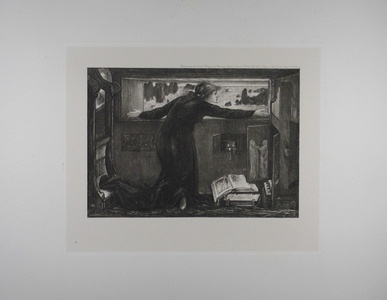| Method | Photogravure |
| Artist | after Sir Edward Coley Burne-Jones |
| Published | Published by the Berlin Photographic Company Berlin. _ London W.133 New Bond Street. _ New York 14 East 23rd Street. [c.1900] |
| Dimensions | Image 173 x 246 mm, Plate 243 x 303 mm, Sheet 507 x 667 mm |
| Notes |
Printed on India laid paper. Plate 4, taken from Burne-Jones' 1871 bodycolour 'Dorigen of Bretagne longing for the safe return of her husband', from 'The Work of Edward Burne-Jones, Ninety-One Photogravures Directly Reproduced from the Original Paintings'. Only two-hundred copies of the 'The Work of Edward Burne-Jones...' were produced, each of which was signed by Philip Burne-Jones, the eldest son of Edward. Medieval literature proved to be a highly influential source for the Pre-Raphaelites, as is demonstrated by Burne-Jones' 'Dorigen of Bretagne', which takes it's subject from Geoffrey Chaucer's 'Franklin's Tale', featured in 'The Canterbury Tales'. The scene focuses on a particular aspect of 'Franklin's Tale'; Dorigen's longing and concern for her husband, Arveragus, who had travelled to Britain to seek honour and fame. Dorigen is depicted at a window, gazing out over the treacherous sea, and awaiting the safe return of Arveragus. In 'Franklin's Tale', Chaucer describes Dorigen falling to her knees with fears that her husband will be shipwrecked. Burne-Jones' choice of posture for the figure of Dorigen alludes to this particularly emotional charged moment. To the right of the composition sits a portable organ, decorated with two ghostly figures, which reference the reunion that Dorigen so desperately longs for. Sir Edward Coley Burne-Jones, 1st Bt (1833-1898) was a painter and designer closely associated with the later phase of the Pre-Raphaelite movement. Burne-Jones met William Morris as an undergraduate of Exeter College, Oxford, whilst studying for a degree in theology. The pair went on to work very closely together on numerous decorative arts projects including stained glass windows, tapestries, and illustrations. Originally intending to become a church minister, Burne-Jones never finished his degree, choosing instead to pursue an artistic career under the influence of Dante Gabriel Rossetti. Rossetti heavily inspired his early work, but by the 1860's his idiosyncratic style was beginning to develop. His mature work, however different in total effect, is rich in conscious echoes of Botticelli, Mantegna and other Italian masters of the Quattrocento. Thusly, Burne Jones' later paintings of classical and medieval subjects are some of the most iconic of the Pre-Raphaelite movement. He was at the height of his popularity during the 1880's, though his reputation began to decline with the onset of the Impressionists. He was created a baronet in 1894, when he formally hyphenated his name. The Berlin Photographic Company, (1880 - 1920; fl) or the Berlin Photographische Gesellschaft, was a German print publishers who specialised in photogravures after Old Masters and contemporary painters. High quality photographs were taken of the original works. The negatives were then exposed onto a gelatin covered copper plate, etched with acid, and printed in a similar fashion to an engraving. The main series of the Berlin Photographic Company's publications is kept together at Blythe House, West Kensington. Condition: Some foxing and discolouration to margins, water stain to lower right corner of sheet, not affecting image. |
| Framing | unmounted |
| Price | £375.00 |
| Stock ID | 41487 |

